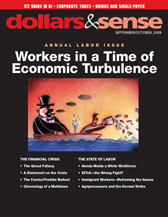Notes on the Financial Crisis, #2
This is a web-only article from the website of Dollars & Sense: The Magazine of Economic Justice available at http://www.dollarsandsense.org

This is a web-only article, available only at www.dollarsandsense.org.
Subscribe Now
at a 30% discount.
Second in a series on the financial crisis. For the first part of the series, click here.
20. The modified bailout bill was approved by the expected huge margin in the Senate (74-25, on Oct. 1) and by an unexpectedly large margin in the House (263-171, on Oct. 3). The margin in the House is attributable in part to mounting fears about the consequences of a second rejection a bailout bill, in the context of a worsening credit crunch and growing stock market volatility, and in part to the sweeteners added on to the original bill.
21. I was at first surprised that in the House vote more Democrats on the Left than Republicans on the Right switched their earlier “no” votes to support the modified bailout bill—including such progressive Leftists as Barbara Lee and Donna Edwards. It turns out that Barack Obama made numerous calls to members of the Congressional Black Caucus, most of whom had voted “no” on Monday, to convince them to vote “yes” on Friday. His strongest argument was that he would work hard (presumably as President) to revise bankruptcy laws in order to allow judges to restructure burdensome mortgages held by homeowners threatened by foreclosures.
22. Another hopeful sign is that (thanks to Dodd and Frank) the modified bailout bill expands the options available to the Treasury Secretary to deal with the crisis. Not only does it call for the U.S. Treasury to buy toxic assets from Wall St. firms, hoping ultimately to be able to sell some of them at higher prices and thereby recoup part of the bailout costs for taxpayers. Two further tactics have been added to the modified plan, both of which would serve to enable taxpayers—rather than just the owners of financial firms—to benefit from improvement in the viability of those firms:
- (a) in return for taking on the risk of toxic assets, the Treasury is supposed to get equity shares in the financial firms, which would allow taxpayers to benefit from any long-run improvement in the stock values of those firms;
- (b) the Treasury is authorized to make direct capital injections in order to boost the capital base of financial firms, and in exchange receive preferred equity shares (or similar securities) whose value will rise if and when those firms recover. This recapitalization alternative to buying and selling toxic assets is of the kind practiced by Warren Buffett and preferred by many economists, notably the progressive Nobel Prize laureate Joe Stiglitz; whether the Treasury Secretary will act on it will depend on who is his/her boss!
23. None of this means that we are likely to avoid a major economic downturn. The Government’s monthly unemployment and jobs report issued on October 3 showed the ninth consecutive—and by far the worst—month of job losses in 2008; and this was based on data gathered in September, prior to the financial trauma of the last two weeks. Things are going to get a good deal worse before they can get better. Among other things, a new fiscal stimulus bill is sorely needed—one that will be oriented to state governments, starved for cash, and to those who are suffering most from unemployment and unmanageable mortgage payments.
24. The coming elections—both presidential and congressional—are absolutely critical. Barack Obama has shown stronger signs of readiness to pursue the measures needed to make the bailout effort succeed, and in a way that is fair to all concerned. In order to follow through, he needs to be prodded and supported by substantial Democratic majorities in both houses of Congress.
25. For those who seek a clear and comprehensible understanding of the related housing and financial crises, and are willing to devote a couple of hours to the effort, I recommend enthusiastically two recent shows from Ira Glass’s public radio program “This American Life.” The first, on the housing crisis, is entitled “The Giant Pool of Money;” it is show #355, dated May 9, 2008. The second, on the financial crisis, is entitled “Another Frightening Show about the Economy;” it is show #365, dated October 3, 2008. You can find and listen to or download these shows from the program archive at the website.

